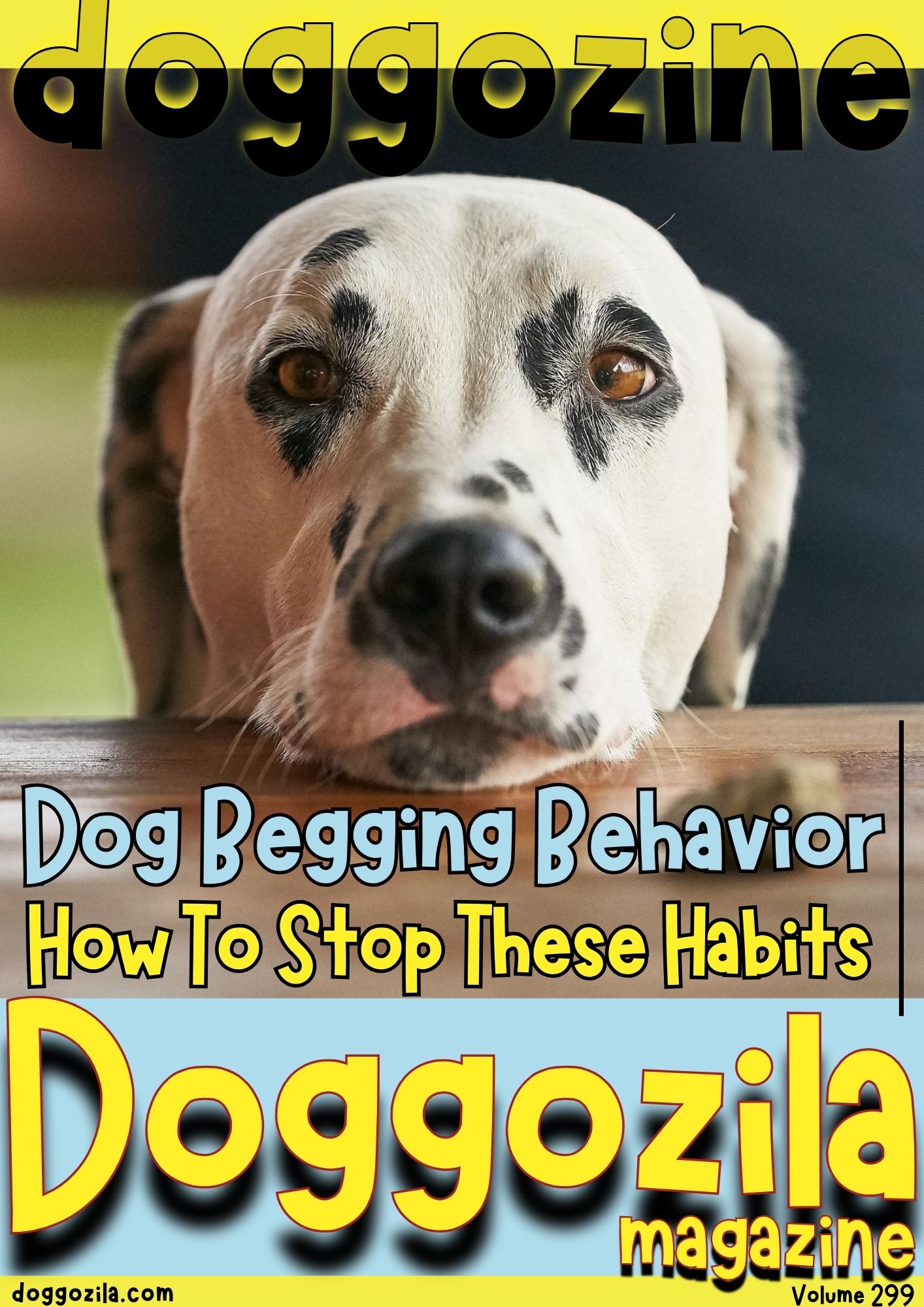Dog begging behavior is a common issue many pet owners face. Those pleading eyes and persistent paws can be hard to resist, but giving in can lead to unwanted habits and health issues for your furry friend. In this blog post, we’ll explore the signs of begging behavior in dogs, why they do it, and effective strategies to prevent it.

UNDERSTANDING DOG BEGGING BEHAVIOR
Understanding the signs of begging behavior in dogs is essential for pet owners who wish to establish a harmonious relationship with their furry companions. Dogs communicate their needs and desires through various behaviors, and begging for food or attention is a common means of expression.
Addressing Dog Begging Behavior
Preventing begging behavior in dogs requires patience, consistency, and a clear understanding of why do dogs beg. By implementing the strategies from this article, you can help your dog develop better habits and ensure a more peaceful mealtime for everyone. Remember, the key is to be consistent and to reinforce positive behavior while ignoring the begging. With time and effort, your dog will learn that begging is not an effective way to get what they want.

WHY DO DOGS BEG?
Dogs beg primarily because it works. Over time, they learn that certain behaviors, like sitting by the table or giving you those irresistible puppy eyes, often result in getting what they want—usually food. This behavior is rooted in their evolutionary history as scavengers. The dog begging behavior is a complex issue influenced by various underlying motivational factors.
Reasons Of Dog Begging Behavior
One of the most prominent reasons dogs beg is hunger. When dogs are not adequately fed or their meals are insufficient, they may resort to begging as a means of seeking food. It is crucial for pet owners to ensure that their furry companions receive a balanced diet that meets their nutritional needs, which can help reduce the likelihood of this behavior stemming from genuine hunger.
Another significant factor contributing to begging behavior is learned behaviors from past experiences. Dogs are intelligent creatures that quickly pick up on what works to achieve a specific outcome. If a dog has previously received food or treats after begging, they are likely to continue this behavior in hopes of obtaining similar rewards in the future. This learned association can create a cycle where the dog begs, receives a reward, and thus reinforces the behavior further.
Dog Begging Behavior as Attention Seeking Mechanism
Many dogs engage in begging as an attention-seeking mechanism. Dogs are social animals that thrive on interaction with their human caregivers. If they sense that begging garners their owner’s attention, whether positive or negative, they may resort to this behavior more frequently. This is particularly common in breeds known for their affectionate tendencies. Certain breeds may be genetically predisposed to exhibiting begging behaviors, further complicating the issue.
Moreover, human reactions to begging can exacerbate the situation. Pet owners who give in to their dog’s pleas may inadvertently reinforce the begging habit, making it a recurring behavior. Understanding these motives is crucial for pet owners who wish to address and curb begging behavior effectively. By recognizing the reasons behind their dog’s begging, owners can take informed actions to modify this behavior and foster a healthier relationship with their pets.

SIGNS OF DOG BEGGING BEHAVIOR
One of the most noticeable signs of begging is when a dog begins pawing at their owner’s leg or the table, indicating a desire for food or a need for interaction. This behavior can often become more pronounced during meal times, when the dog is eager to share in the experience.
Common Dog Begging Behaviors
- Staring: Your dog may fixate on you or your food with intense, unblinking eyes.
- Whining or Barking: Vocalizations are a common way for dogs to express their desire for food.
- Pawing or Nudging: Physical contact, such as pawing at your leg or nudging your hand, is a direct way to get your attention.
- Jumping: Some dogs may jump up to get closer to the food or to you.
- Drooling: Excessive drooling can be a sign that your dog is anticipating food.
- Following You: Your dog might follow you around, especially when you have food or are near the kitchen.
Another common signaling behavior is whining or whimpering. This vocal expression can vary in intensity, from soft whines to louder cries, depending on the dog’s urgency for attention. Such vocalizations are often accompanied by a focused gaze directed at the food source or the owner, showcasing an intense longing or expectation. Dogs may also adopt a particular posture, such as sitting or lying down near their owner while looking up expectantly, further reinforcing their desire for a treat or interaction.
Recognize The Context of Begging Behavior in Dogs
Some dogs demonstrate their begging behavior through persistent following during meal preparation or eating. This can involve weaving between their owner’s legs, sitting nearby with an eager expression, or even employing dramatic techniques like play-bowing in hopes of eliciting a response.
Understanding the context of these behaviors is crucial, as it allows owners to distinguish between normal begging—where a dog shows interest in mealtimes—and more excessive or problematic pleading that may stem from learned behaviors or environmental influences.
In recognizing these signs, owners can better understand their dog’s motivations and needs, paving the way for effective strategies to manage or redirect begging behavior appropriately. This foundational knowledge is key to addressing any underlying issues that could contribute to excessive begging.

WHY IT’S IMPORTANT TO PREVENT DOG BEGGING BEHAVIOR
Allowing begging can lead to several issues such as health problems. Feeding your dog table scraps can contribute to obesity and other health problems, also can lead to behavioral issues. Begging can escalate into more demanding behaviors, such as barking or jumping on guests. If you have trained your dog previously, giving in to begging undermines training efforts and can confuse your dog about acceptable behavior.
How to Prevent Dog Begging Behavior
Preventing begging behavior requires consistency and patience.
Here is what you should consider:
- Ignore the Behavior: One of the most effective ways to stop begging is to ignore it completely. Do not give your dog any attention when they beg, as even negative attention can reinforce the behavior.
- Establish a Feeding Routine: Feed your dog at the same times each day, and ensure they are not hungry during your mealtimes. A well-fed dog is less likely to beg.
- Use a Designated Eating Area: Train your dog to stay in a specific area during your mealtimes. This could be a bed, crate, or another room. Reward them for staying in their designated spot.
- Teach Basic Commands: Commands like “sit,” “stay,” and “go to your place” can be very helpful. Use these commands to redirect your dog’s attention away from begging.
- Provide Distractions: Give your dog a toy or a puzzle feeder to keep them occupied while you eat. This can help divert their attention from your food.
- Consistent Training: Ensure everyone in the household is on the same page. Consistency is key to preventing begging behavior. If one person gives in, it can undo the progress made by others.
- Positive Reinforcement: Reward your dog for good behavior. When they stay in their designated area or follow commands, give them a treat or praise. This reinforces the behavior you want to see.
Effective Strategies to Curb Begging Behavior
Managing and reducing begging behavior among dogs requires a multifaceted approach that emphasizes training, engagement, and positive reinforcement. One effective strategy involves establishing a consistent feeding schedule. By providing meals at the same times every day, pet owners create a predictable routine, allowing dogs to learn when to expect food, which can ultimately reduce their begging behavior during mealtimes.
Training techniques play a crucial role in altering begging habits. Teaching commands such as “leave it” or “go to your place” can redirect a dog’s focus away from begging. These commands provide an alternative action that the dog can take when they feel the impulse to beg. It is essential to reward dogs for following these commands with treats, praise, or affection, reinforcing the desired behavior. Consistency is key in this training process; every family member should understand and apply the same commands and strategies to avoid confusing the dog.
Dog Training, Structured Schedules, And Engaging Activities
Alternatively, ensuring that dogs engage in adequate physical and mental stimulation can help alleviate some of the frustration that leads to begging behavior. Activities such as regular walks, playing fetch, or providing interactive toys can help expend excess energy and distract dogs from their hunger-induced begging. Puzzle toys, for instance, require dogs to solve challenges to access treats or food, offering mental stimulation while discouraging unwanted behaviors.
Positive reinforcement, a technique in behavioral training, should not be overlooked. Instead of acknowledging begging through attention or food rewards, pet owners should only offer treats or petting when their dogs display calm behavior. Over time, the dog learns that patience and calmness yield rewards, thereby diminishing the tendency to beg.
Effectively managing dog begging behavior requires patience, consistency, and a thoughtful approach combining training, structured schedules, and engaging activities. By applying these strategies, pet owners can significantly improve their dog’s behavior and create a more harmonious living environment.
Addressing Persistent Dog Begging
If your dog continues to beg despite your efforts, consider the following:
- Consult a Professional: A professional dog trainer or behaviorist can provide personalized advice and strategies.
- Health Check: Ensure there are no underlying health issues causing increased hunger or food-seeking behavior.
- Adjust Diet: Sometimes, adjusting your dog’s diet to include more fiber or protein can help them feel fuller for longer.
Preventing begging behavior in dogs requires patience, consistency, and a clear understanding of why dogs beg. By implementing the strategies outlined above, you can help your dog develop better habits and ensure a more peaceful mealtime for everyone. Remember, the key is to be consistent and to reinforce positive behavior while ignoring the begging. With time and effort, your dog will learn that begging is not an effective way to get what they want.

HEALTH IMPLICATIONS OF DOG BEGGING BEHAVIOR
Dog begging behavior can indicate a more significant issue that may affect your pet’s health if left unaddressed. One of the most concerning implications of allowing dogs to beg for food is the risk of obesity. Consistently providing table scraps or extra treats encourages dogs to seek more food, leading to an increase in body weight.
Dog Begging Can Cause Health Problems Also Health Issues Can Cause Begging Behavior
Obesity in dogs can result in diabetes, joint problems, and cardiovascular diseases, ultimately compromising their quality of life. Additionally, incessant begging can lead to digestive issues. Dogs are creatures of habit, and when their feeding schedules are disrupted due to the occasional indulgence in begging, it can create an unhealthy feeding pattern.
Overeating can manifest in gastrointestinal problems, such as bloating or pancreatitis, which can be serious conditions requiring medical intervention. Therefore, it is crucial to avoid giving in to begging as it may foster improper eating habits and subsequent health issues.
Another significant aspect to consider is the impact of begging behavior on the dog’s relationship with food. When pets are rewarded for begging, they may come to associate food only with attention-seeking and reinforcement rather than as a means of nourishment.
Functional Relationship Can Lead To Happy And Healthy Dogs
This dysfunctional relationship can lead to anxiety and stress during mealtime, further complicating their overall well-being. Establishing boundaries by implementing a regular feeding schedule is essential in promoting healthy eating habits. This consistency not only supports a balanced diet but also fosters a healthier relationship between the dog and its food.
To maintain your pet’s health, it is vital to address begging behavior as early as possible. Taking proactive steps to set clear boundaries and adhere to a consistent feeding routine can help prevent potential health concerns in the future, ensuring your beloved canine companion remains happy and healthy.

DOG BEGGING BEHAVIOR INSIGHTS FROM RESEARCH AND REAL-LIFE EXAMPLES
We all love our furry friends, but sometimes their begging behavior can become a bit overwhelming. It often leaves us wondering why they act this way and how we can manage it. By conducting studies and research on dog begging behaviors, we can better understand the underlying reasons for such actions.
Why Research and Learning from Real-Life Examples Matters
There is no denying that each dog is unique, and their begging habits can vary widely. Learning from real-life experiences can provide necessary insights into how other dog owners have tackled begging issues. For instance, one owner might find that their dog begs primarily for attention rather than food, while another dog may have developed the habit due to past experiences. Hearing these stories can equip us with practical solutions and also remind us that we’re not alone in the journey of dog parenting.
Incorporating research-based strategies into our everyday routines can lead to lasting changes and a happier home for both us and our dogs. Understanding why our dogs beg for food or attention allows us to respond appropriately, fostering a deeper bond with our furry companions. Whether it is by sharing our stories or learning from others, research into dog begging behaviors is an essential part of being a responsible pet owner.
Recent Studies and Research on Dog Begging Behavior
Recent studies have provided valuable insights into why dogs beg and how this behavior can be managed.
Here are some key findings:
- Evolutionary Background: Dogs have evolved from wolves, who were opportunistic feeders. This scavenging behavior has been passed down, making dogs naturally inclined to seek out food whenever possible.
- Cognitive Abilities: Research has shown that dogs possess a rudimentary theory of mind, allowing them to understand human cues and manipulate their behavior to get what they want. For instance, a study by Udell et al. demonstrated that dogs can differentiate between attentive and inattentive humans when begging for food.
- Behavioral Conditioning: Dogs learn begging behavior through reinforcement. When a dog begs and receives food, this behavior is positively reinforced, making it more likely to be repeated. This is supported by studies showing that dogs are highly responsive to human social cues and can quickly learn which behaviors are rewarded
- Impact of Human Interaction: The way humans interact with their dogs significantly influences begging behavior. Studies have found that dogs living in environments where they are frequently given table scraps are more likely to develop persistent begging habits.
Real-Life Examples from Dog Owners
To provide a practical perspective, here are some real-life examples shared by dog owners, about their experiences with begging behavior:
Case of Max the Labrador
Sarah, a dog owner from New York, shared her experience with her Labrador, Max. “Max used to beg constantly during our meals. He would sit by the table, drooling and whining. We realized that we had been giving him scraps too often, reinforcing his begging. We started ignoring his begging and only fed him in his designated area. It took a few weeks, but Max eventually stopped begging at the table.”
Bella the Beagle’s Transformation
John, from California, talked about his Beagle, Bella. “Bella was a master beggar. She would paw at us and bark until we gave in. We consulted a trainer who advised us to use a baby gate to keep Bella out of the dining area during meals. We also started giving her puzzle feeders to keep her occupied. The change was remarkable. Bella now stays calm during our meals and waits patiently for her food.”
Dog Training Tips from a Professional to Prevent and Manage Begging Behavior
Emma, a professional dog trainer, shared her insights. “Consistency is key when dealing with begging behavior. I always tell my clients to ensure everyone in the household follows the same rules. If one person gives in, it can undo all the progress. Using commands like ‘go to your place’ and rewarding the dog for staying there can be very effective.”
Let’s Wrap Up!
Preventing begging behavior in dogs requires patience, consistency, and a clear understanding of why dogs beg. By implementing the strategies outlined above and learning from real-life examples, you can help your dog develop better habits and ensure a more peaceful mealtime for everyone. Remember, the key is to be consistent and to reinforce positive behavior while ignoring the begging. With time and effort, your dog will learn that begging is not an effective way to get what they want.









